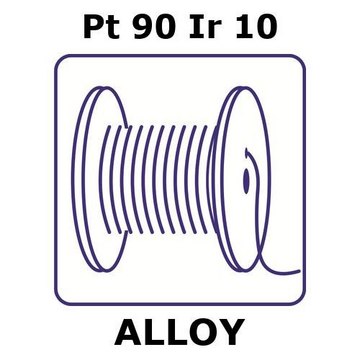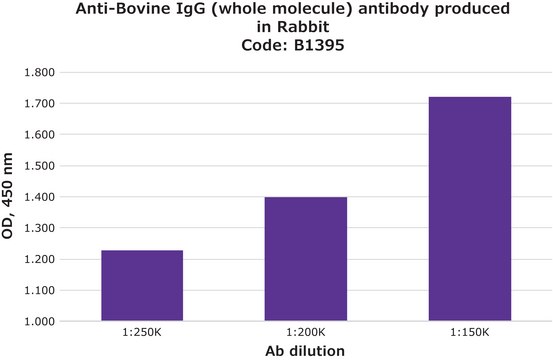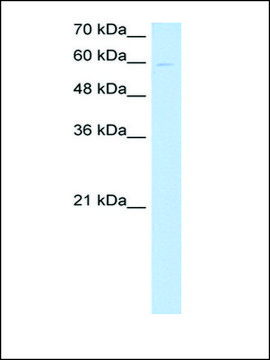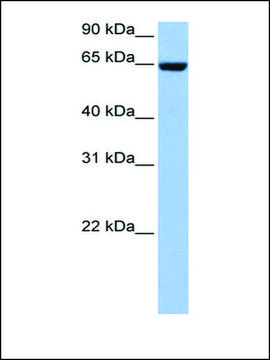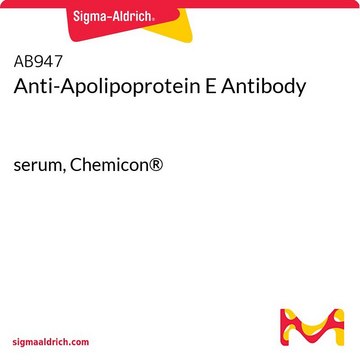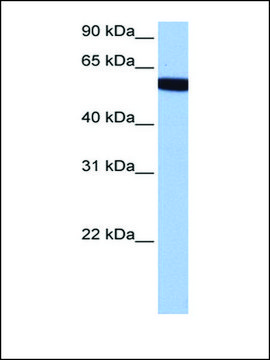推荐产品
生物来源
rabbit
偶联物
unconjugated
抗体形式
affinity isolated antibody
抗体产品类型
primary antibodies
克隆
polyclonal
表单
buffered aqueous solution
分子量
34 kDa
种属反应性
human
浓度
0.5 mg - 1 mg/mL
技术
immunohistochemistry: suitable
western blot: suitable
NCBI登记号
UniProt登记号
运输
wet ice
储存温度
−20°C
靶向翻译后修饰
unmodified
基因信息
human ... APOE(348)
一般描述
APOE gene encodes for Apolipoprotein E, a main apoprotein of the chylomicron. ApoE is a 299 amino acid containing plasma protein with a molecular weight of 34kDa. It is synthesized primarily in liver and is mapped on to chromosome 19 in a cluster with APOC1 and APOC2.
免疫原
Synthetic peptide directed towards the N terminal region of human APOE
应用
Anti-APOE antibody produced in rabbit is suitable for western blotting at a concentration of 1μg/mL.
生化/生理作用
ApoE binds to its specific receptor and mediates the transport of lipid and cholesterol, ligands for the low-density lipoprotein (LDL) and very low density lipoprotein (VLDL) receptors, through the bloodstream. It is also involved in repair mechanism against tissue injury. For example, increased amounts of apolipoprotein E are present at peripheral nerve injury and regeneration site. Mutation in APOE gene leads to familial dysbetalipoproteinemia, or type III hyperlipoproteinemia (HLP III), in which increased plasma cholesterol and triglycerides results in impaired clearance of chylomicron and VLDL remnant.
序列
Synthetic peptide located within the following region: KVLWAALLVTFLAGCQAKVEQAVETEPEPELRQQTEWQSGQRWELALGRF
外形
Purified antibody supplied in 1x PBS buffer with 0.09% (w/v) sodium azide and 2% sucrose.
免责声明
Unless otherwise stated in our catalog or other company documentation accompanying the product(s), our products are intended for research use only and are not to be used for any other purpose, which includes but is not limited to, unauthorized commercial uses, in vitro diagnostic uses, ex vivo or in vivo therapeutic uses or any type of consumption or application to humans or animals.
未找到合适的产品?
试试我们的产品选型工具.
储存分类代码
12 - Non Combustible Liquids
WGK
WGK 3
闪点(°F)
Not applicable
闪点(°C)
Not applicable
法规信息
新产品
W A Groenewegen et al.
Arteriosclerosis and thrombosis : a journal of vascular biology, 14(11), 1695-1704 (1994-11-01)
We identified the first insertion mutation that specifies an apolipoprotein (apo)B truncation, apoB-70.5, in a father and son with hypobetalipoproteinemia (total and low-density lipoprotein [LDL] cholesterol < 5th percentile, plasma apoB levels approximately one third of normal). The mutation is
R W Mahley
Science (New York, N.Y.), 240(4852), 622-630 (1988-04-29)
Apolipoprotein E is a plasma protein that serves as a ligand for low density lipoprotein receptors and, through its interaction with these receptors, participates in the transport of cholesterol and other lipids among various cells of the body. A mutant
María Solanas-Barca et al.
Atherosclerosis, 222(2), 449-455 (2012-04-07)
Rare mutations in the APOE gene, undetectable with the usual genotyping technique, are responsible for dominant familial dysbetalipoproteinemia (FD) and therefore could be easily misclassified as familial combined hyperlipidemia (FCHL). We aimed to identify APOE mutations associated with dominant combined
Y K Paik et al.
Proceedings of the National Academy of Sciences of the United States of America, 82(10), 3445-3449 (1985-05-01)
The gene for human apolipoprotein E (apo-E) was selected from a library of cloned genomic DNA by screening with a specific cDNA hybridization probe, and its structure was characterized. The complete nucleotide sequence of the gene as well as 856
Barbara Castella et al.
Nature communications, 8, 15663-15663 (2017-06-06)
Vγ9Vδ2 T cells are activated by phosphoantigens, such as isopentenyl pyrophosphate (IPP), which is generated in the mevalonate pathway of antigen-presenting cells. IPP is released in the extracellular microenvironment via unknown mechanisms. Here we show that the ATP-binding cassette transporter
我们的科学家团队拥有各种研究领域经验,包括生命科学、材料科学、化学合成、色谱、分析及许多其他领域.
联系技术服务部门